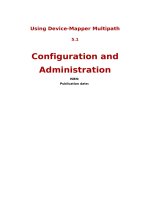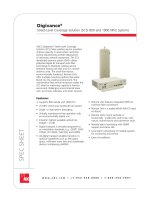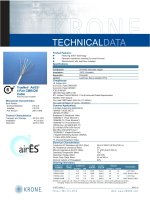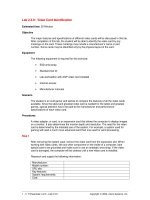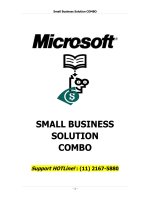Tài liệu ComboSBSFinal ppt
Bạn đang xem bản rút gọn của tài liệu. Xem và tải ngay bản đầy đủ của tài liệu tại đây (3.57 MB, 130 trang )
Small Business Solution COMBO
SMALL BUSINESS
SOLUTION
COMBO
Support HOTLine! : (11) 2167-5880
-1-
Small Business Solution COMBO
TABLE OF CONTENTS
Introduction ............................................................................................................ 4
The five myths of technology ................................................................................ 4
Technology is expensive ............................................................................................................... 4
Technology is complex ................................................................................................................. 5
Technology requires internal maintenance ...................................................................................... 5
Technology is insecure ................................................................................................................. 6
Technology is not necessary in my business ................................................................................... 6
What does a network do? ..................................................................................... 7
Peer-to-Peer Network ........................................................................................... 8
Network Elements .............................................................................................. 10
Types of Servers ................................................................................................ 12
Authentication Server ................................................................................................................. 12
Application Server ...................................................................................................................... 13
How a server can be useful to your business ............................................................ 13
Centralization of Documents ................................................................................ 13
Security ............................................................................................................. 14
Data Backup ...................................................................................................... 14
Electronic Mail .................................................................................................... 15
Fax Service ........................................................................................................ 15
Collaborative Portal ............................................................................................ 15
Internet ............................................................................................................. 15
The role of SBS in your company ............................................................................ 16
Keep your data protected .................................................................................... 16
Maximize company’s productivity ......................................................................... 17
More Effective Communications ........................................................................... 18
Get and keep more clients................................................................................... 18
Resources of the Standard Edition ....................................................................... 19
Windows Server 2003 ................................................................................................................. 19
Windows SharePoint Services ...................................................................................................... 19
Exchange Server 2003 Technology .............................................................................................. 19
Microsoft Office Outlook 2003 ..................................................................................................... 19
Microsoft Shared Fax Service ...................................................................................................... 19
Routing and Remote Access Services (RRAS) ................................................................................ 19
System Requirements ............................................................................................ 20
Server ............................................................................................................... 20
Clients ............................................................................................................... 20
Licensing .............................................................................................................. 21
Buying Small Business Server from a retailer ........................................................ 21
Buying Small Business Server in a new computer .................................................. 21
-2-
Small Business Solution COMBO
Buying Small Business Server with a volume discount ............................................ 22
SBS Installation ..................................................................................................... 23
To Do List ............................................................................................................. 46
External domain name ........................................................................................ 46
Printer list .......................................................................................................... 48
User List ............................................................................................................ 49
Naming Rules..................................................................................................... 49
Final Adjustments .................................................................................................. 50
Network Tasks ................................................................................................... 50
Security Practices ....................................................................................................................... 51
Connect to the Internet .............................................................................................................. 52
Configuring the Remote Access ................................................................................................... 62
Activating the server .................................................................................................................. 65
Adding Client Licenses ................................................................................................................ 67
Management Tasks............................................................................................. 69
Add a Printer ............................................................................................................................. 69
Monitoring Options ..................................................................................................................... 74
Configuring Fax Settings ............................................................................................................. 77
Configuring Backup .................................................................................................................... 85
Installing Service Pack1 ...................................................................................... 90
Management of Small Business Server Provider ...................................................... 100
Users .............................................................................................................. 101
Computers ....................................................................................................... 104
Internal Website............................................................................................... 107
Creation .................................................................................................................................. 107
Managing Access ..................................................................................................................... 109
Information Center ........................................................................................... 111
Client Configuration ............................................................................................. 113
Services for Small and Medium Businesses ............................................................. 116
Rendering Services to Small and Medium Businesses ........................................... 116
Training your team to serve your clients ............................................................. 118
Portfolio of Services for Small and Medium Businesses......................................... 120
Basic Installation of MS Small Business Server ............................................................................ 120
Customizations of MS Small Business Server ............................................................................... 120
Administration of MS Small Business Server ................................................................................ 121
Management of Workstations .................................................................................................... 122
Maintenance and Services Agreement ........................................................................................ 123
Summary of Services ........................................................................................ 124
Glossary.............................................................................................................. 125
Appendix I – Suggested Schedule for the Implementation of MS Small Business Server
.......................................................................................................................... 129
-3-
Small Business Solution COMBO
Introduction
This guide represents an important landmark regarding the use of SBS 2003, as it brings
a more practical and didactic approach to the solution uses. By using a more accessible
language and terms that are more aligned with the market and business reality — thus
leaving behind those once incomprehensible terminology —, Microsoft is providing all its
users and consultants with a documentation that’s crucial for the understanding and
better use of Small Business Server 2003. Enjoy it!
The five myths of technology
Technology has evolved over time – not only in a technical sense but also in the way it
interacts with men. Using the jargon of the industry, for the first and only time, software
has become more "friendly". Translation: computer programs are now easier and more
intuitive to use. It is simple, isn’t it? Even microcomputers, known as PCs (personal
computers) have now resources that simplify their use and make it very easy to install
additional equipment such as printers — there is no need to call a friend of a friend to
perform such a "complicated" task
The last argument employed by micro and small companies to avoid using technology in
their business is cost. With fewer resources and unable to make significant investments,
technology has always been considered an unnecessary ―expense‖. If you are one of the
entrepreneurs who fit in this category, this content will show you that, when adequately
applied, computing resources can help you reduce costs, and make your company more
efficient and productive.
And the reason for your company to stop spending money with technology and start
investing in technology is simple: technology is no longer designed only for the big ones.
Computing tools are accessible to any company, regardless its size. Not using it means
missing a chance to grow. Adopting it adequately will give relevance to your investment
and bring results to your business.
Technology is expensive
This is no longer true. Prices have been falling due to the fierce
competition among the main suppliers and the technological evolution.
You can now find PCs for about 2 thousand reais and servers (computers
that centralize information in a network) for a little over 2 thousand reais.
When a technology benefits a company’s business and is adequately used, the return on
investments covers its costs. The purchase of a notebook, for instance. Acquiring such
equipment for a professional who works eight hours a day at a company office may be
expensive and unnecessary. However, acquiring it for a sales team that needs the
support of mobile technologies is a good investment.
-4-
Small Business Solution COMBO
Technology is complex
Well, this is sort of true. It’s always necessary to have some knowledge,
even when handling the easiest software packages. But much has
changed from the first computer programs to the current operating
systems. The major concern of software developers and of Microsoft —
which has 95% of the PC applications market — is to create programs that
are increasingly easier to use and simplify the installation of peripherals such as printers,
mouses, keyboards, scanners, etc.
Technology requires internal maintenance
What is happening worldwide is that, with market stability, companies are
trying to become more effective by focusing on processes in which they
are experts (Core processes), leaving the non-Core processes to partners.
They are forming alliances with suppliers/ partners and therefore replacing
fixed costs with variable costs. Their suppliers are handling individual processes of the
supply chain that once integrated form a value chain. As a result of outsourcing,
companies have more time and money to focus on what matters the most: CLIENTS and
new revenues. By doing this, companies should be able to focus on ―nobler‖ activities
and outsource activities that are not so ―noble‖. Depending on the complexity of your
technology infrastructure, it might be interesting to take advantage of some of the
several services in the market that offer a good cost/benefit. Technology companies
have also developed custom service solutions, available in packages at a lower price —
compared to the price of conventional services — which may meet the needs of the
majority of the micro and small businesses. These packages offer a wide range or
services, such as installation and configuration of equipment and operating systems,
extended warranties and onsite technical support, and phone support that can help
clients identify and solve eventual problems. In addition, clients can always choose the
most convenient package, according to their company’s needs and budget.
-5-
Small Business Solution COMBO
Technology is insecure
The widespread use of technology tools and Internet has increased the
risk of external attacks. Viruses and malicious codes, which are
downloaded to a computer without the user’s knowledge, can capture
banking passwords. Simple security procedures can help minimize such
risks. Antivirus software packages also block the main viruses. However, bear in mind
that the main security threats do not come from the outside, but from inside your own
company. Research shows that 80% of the attacks and attempts of invasion are
performed by employees or former employees of the company. If you train your staff,
use technology in a proper way, and have security procedures in place, the risks of
problems and attacks can be minimized. Otherwise, it’s just like buying an armored car
and driving it with the windows open.
Technology is not necessary in my business
Where are you? In the beginning of the 20th century? A polemic article by
Nicholas G. Carr, former executive-director of Harvard Business Review,
the major business magazine in the world, defended the idea that
technology has turned into a commodity, just like railways and electric
networks. According to him, not using technology is like being out of the
game. It’s true that some businesses require more technology than others. But there is
no doubt that it is always possible to reduce costs, drive growth, enhance processes,
and improve customer service by investing in technology.
For more information, visit the websites:
/> />
-6-
Small Business Solution COMBO
What does a network do?
A computer network is a set of equipment (desktops, servers, printers) and information
that is linked in order to allow information sharing. Apart from this big convenience for a
company, a network can offer the following features:
Shares and protects resources
Increases efficiency
Reduces Costs
A network can centralize data and share it
according to the company’s user guidelines,
preventing undue access. In addition to that,
with centralized data it's possible to have
backups to protect this data in case of
disasters.
Users are more efficient when they have
access to important files, computer programs
and the internet at all times. A network that
allows remote access increases speed and
provides mobility when it enables users to
access e-mails in an efficient, easy and quick
way.
With shared resources, several users can
access a single resource — a printer, for
instance, avoiding the need of acquiring and
installing these resources individually.
-7-
Small Business Solution COMBO
Peer-to-Peer Network
In a peer-to-peer network, there are no dedicated servers or hierarchy among
computers — all computers are equal. Normally, each computer works both as a client
and a server for devices and data, and none of them is assigned to function as a
network administrator. Users establish which data is shared over the network.
Picture 1 – Peer-to-Peer Network Scheme
Some characteristics of a peer-to-peer network:
Used for smaller networks (up to 10 computers)
Few security guidelines
All users are located in the same general area
Network growth becomes limited
Each computer sharing its resources requires a large percentage of processing to
support local user and network applications
Each user is responsible for managing his or her own resources, so there is a
higher risk of data loss and inadequate data handling.
Each user is entirely responsible for his/her data backups.
-8-
Small Business Solution COMBO
Client/Server Networks
Networks in which security and information availability matters are considered important
require the use of dedicated servers. This kind of equipment is more robust and its
operating system is able to centralize data (for instance, e-mails and internet access).
The most remarkable characteristic of the equipment is its scalability — in many
instances, there is no need to replace equipment and systems to expand the network,
which reduces the cost of ownership.
Picture 2 –Client/Server Network Scheme
Characteristics of a Client/Server network
Sharing resources becomes securer and faster, as they will always come from a
single source.
Security is a strength once it’s possible to control users' access to information
and resources from a single point.
Data backup will be dynamic and performed by the network administration team,
and not by each individual user.
Users will be able to have their equipment more dedicated to their applications.
Network growth follows company’s growth.
The network server can offer several services such as: e-mail, internet, fax,
printing, filing, etc.
-9-
Small Business Solution COMBO
Network Elements
A standard computer network is comprised of connectivity equipment, which varies
according to each project. Below there is a list of the most used equipment:
Equipment
Server
Picture
Description
Specialized
computer
which
centralizes company data, shared
resources and data protection
activities.
Can be used for specialized
applications — as an e-mail server,
for example.
User’s equipment that accesses the
internet, shared resources, as well
as local and network applications: It
can be of two kinds:
Workstation
Desktops: Equipment that remains
at offices and do not has a built-in
CPU, monitor, keyboard, and
mouse.
Desktops
Notebooks:
More
compact
equipment in which resources are
integrated; for this reason, they
offer greater portability.
Notebooks
Switch
Connectivity device used to connect
workstation cables to servers, thus
enabling
data
communication
through the network. It’s also called
concentrator.
- 10 -
Small Business Solution COMBO
Equipment
Router
Picture
Description
Equipment used to connect two or
more networks. It’s often used to
connect a company to the internet.
Cables
Physical means used to connect
workstations, servers and routers.
They must always be connected to a
switch.
Network
Card
It’s the connection point of a
workstation or server in a network.
Enables the use of cables.
Software
Facilitates the use of the hardware
(equipment) and should be installed
on servers and workstations so that
users can perform their tasks.
Firewall
Device (or software) used to protect
a company's network against
attacks from ill-meaning people
through the internet.
- 11 -
Small Business Solution COMBO
Below is an example of a network including its elements and connections:
SBS 2003
Server
Switch
`
Pete’s Desktop (Windows XP Pro)
Router
Karen’s Laptop (Windows XP Pro)
Printer
Firewall
Internet
Picture 3 – Network Map
Types of Servers
In a client/server network it’s important to analyze how servers are used. See example
below:
Note: When it comes to server services, they can be concentrated in only one
computer (physical) which performs several tasks.
Authentication Server
An authentication server is used to check if the name of a registered user (Logon) and
his/her password are authentic, that is, if they are the same as registered in this server.
Another function of the authentication server is to guarantee that network resources
(such as printers and the internet) and data are accessed according to the company's
directives.
- 12 -
Small Business Solution COMBO
Application Server
The application server is, by definition, aimed at performing a specific network task.
Currently there is a great number of market applications, see some examples below:
Electronic Mail
Fax
Internet
Files
Printing
Databank
Centralizes users’ e-mail boxes and handles all e-mail
communications — inside and outside the company.
Works as a fax service center, where all inbound faxes are sent
electronically to their recipient who can print it at any time.
Centralizes all internet accesses, eliminating the need of
installing individual modems, which results in real savings. Can
manage access flows, providing higher protection to company
data.
Centralizes users’ individual folders, keeping their individuality
and ensuring data backup, bringing more security to a work
environment.
Shared printers are stored in a single server so that workstations
do not need to use their individual resources — this makes the
process easier to users.
Contains corporate data in an organized manner. Centralizes the
main data of a company, and handles security, backup and
access to this data.
How a server can be useful to your business
Having analyzed the importance of servers within a company, let’s see some of the most
common benefits of using them in a network environment.
Centralization of Documents
With all users’ documents centralized into a single point, it's easier to set security
guidelines in order to grant access to information to a user or group of users.
Another advantage is that it allows documents to be quickly viewed by a group. Also,
data can be transferred in a safe and reliable manner.
- 13 -
Small Business Solution COMBO
Security
Security is the most important issue when it comes to adopting a server-based network.
This includes performing user authentication at a single access point and controlling the
access to a company’s internal and external data and resources. This model covers all
levels of data access, from the e-mail server – to which the right directives for sending
and receiving messages can be applied – to the internet server, where internal internet
access are monitored and attacks from external websites are prevented.
Other aspects covered by security are:
Guidelines that restrict access to workstation components (for example, the
control panel);
Access permissions to folders and applications;
Access restrictions to the server itself;
Monitoring the access to resources and data of the company through audit;
Defining users LOGON times;
Defining which users can log on to a certain workstation.
Data Backup
Making a security copy of the data (called backup) using an external media such as CDs
or Tapes provides extra protection to a company's most crucial data. Therefore, it's
necessary to have a system that is able to fulfill such needs and is easy to handle.
A backup system offers a solution to help even the least experienced users to develop a
simple and effective backup and data recovery strategy.
To recover information, it’s necessary to have a restoration system (called restore)
which restores all the data copied to its original format, folders and security definitions.
- 14 -
Small Business Solution COMBO
Electronic Mail
An electronic mail system must be able to provide immediate communications among all
people in a company, regardless its size. Its main features are:
Mail Box
Notification
Return of Receipt
Answer
Attachments
In an e-mail environment, the administrator creates an e-mail
delivery box for each network user. This box, also known as email address, will be the delivery point for all inbound messages
addressed to its owner.
Addressees can be notified whenever they receive a message.
For that, an e-mail notification screen is displayed, notifying user
of the new message.
Users can be informed whether the messages they sent were
sent, received, or read.
This feature allows the recipient of a message to respond to the
sender, include other recipients to his/her response or even
forward the message to another user.
It’s possible to attach files such as texts, electronic spreadsheets
charts, and images to a message and send everything by e-mail.
Fax Service
The shared fax server does for fax communications what a printer does for printing
operations. All fax capabilities are available to all network users so that they do not have
to leave their workstations to send or receive a fax.
Collaborative Portal
Coworkers can share information in a collaborative and pre-set environment, using a
web page format, in a quick and secure way. These websites include libraries of shared
documents, company events, announcements, external links and other information
which are relevant to the company's business.
Internet
The Internet server plays two roles within a network: one is to centralize accesses to the
Internet by the workstations, drastically reducing costs related to modems and dial-up
connections while increasing the rate of data transmission and reception. The other role
is to monitor website access by users and prevent external attacks to the network.
- 15 -
Small Business Solution COMBO
The role of SBS in your company
In any business, it's essential to secure the most critical data and organize corporate
data, as well as make the maximum use of all the computing equipment and resources.
Implementing the right technology will help you achieve such goals and get more out of
your time and money.
With Windows Small Business Server 2003 you will understand why choosing the right
technology can be more efficient and reduce costs, and why having a good connection
with your clients can make the difference.
For more information, visit the website:
/>
Keep your data protected
With Windows Small Business Server 2003 it’s possible to secure company data and
offer more protection to your network and your business:
Contains a built-in Firewall to protect data against non-authorized access and
help prevent attacks by hackers in up to 60%;
Prevents data loss through an internal backup and restore system which enables
users to easily recover any accidentally deleted data;
Removes virus from attachments automatically and more efficiently, and blocks
messages with malicious content (spam), once it has more effective controls;
Keeps access to data and resources by users protected by a set of
characteristics, including authentication, authorization and encryption of data.
Points of argument
Consider to which extent you and your users depend on a
work environment that is protected against spam and websites
that might bring in viruses, and how important it is to be able
to recover information that has been accidentally deleted.
Many managers say that the greatest benefit brought by
Windows Small Business Server 2003 is the certainty that their
important data is protected.
- 16 -
Small Business Solution COMBO
Maximize company’s productivity
Windows Small Business Server 2003 is specially designed to increase productivity, once
it maximizes the use of the network equipment and resources. It also creates a more
efficient business environment. With Windows Small Business Server 2003, it's possible
to:
Share resources such as applications and Internet access, as well as equipment such as:
printers, fax, CD-ROM units, etc;
Increase cooperation among users through an Intranet that allows documents to
be shared; coordinate work schedules and teamwork in critical projects;
Run multiple applications more efficiently and store large amounts of data
without decreasing the performance of the computers due to system overload;
Be productive even when away from the office through remote access to e-mails,
schedule, contacts and company data.
Points of argument
One of the best aspects of Windows Small Business Server
2003 technology is that it quickly adheres to a company’s
business by performing tasks more efficiently and at a more
attractive, productive and effective cost. When is the best
time for a company to adopt a technology that helps it operate
more effectively? When it comes Windows Small Business
Server 2003, the time is now!
- 17 -
Small Business Solution COMBO
More Effective Communications
With Windows Small Business Server 2003, companies can be managed and connected
to their clients from virtually anywhere. You can:
Access business information, including e-mails, contacts, schedules, applications,
Intranet, and even the company’s computer, through any equipment that is
connected to Internet;
Remotely send electronic messages from your e-mail account, ensuring the
integrity of your brand and keeping track on the performed events.
Points of argument:
The mobility tools of Windows Small Business Server 2003
give your business more flexibility and deep access to
resources. Clients’ proposals will no longer remain unanswered
while your employees are away from the office — they will be
able to access their account anywhere they are, in real time,
as well as to share information such as schedules and tasks,
and update their business information.
Get and keep more clients
Windows Small Business Server 2003 provides tools that help you enhance your
company’s identity and be connected to your client from virtually anywhere in the world.
You can:
Host your website and e-mail to strength your brand and credibility before your
clients;
Communicate with clients and access your information while you are away from
the office via e-mail, contacts, schedule, and other resources of the company, in
real time.
Points of argument
The fact that you are connected to your business in real time,
even when away from the office, increases your efficiency
before your client. Studies* show that having the ability to
quickly respond to clients significantly increases the financial
return. With Windows Small Business Server 2003, you keep
your clients well-informed and served.
* Studies based on Forbes. For more information, visit:
/>
- 18 -
Small Business Solution COMBO
Resources of the Standard Edition
Small companies need to access, update, share, and store increasing amounts of
information. In order to attain advanced security in a small corporate network you must
have tools for printing, collaboration, e-mail, Internet connectivity, fax and support that
are specially designed for mobile employees. That’s why Windows Small Business Server
2003 offers the following resources:
Windows Server 2003
This reliable operating system has advanced security features, and helps keep your
internal network data always available. It also includes the service efficiency of the
Microsoft Active Directory® directories and its tools.
Windows SharePoint Services
Team members can communicate and collaborate with each other more easily through
this new website solution. You can manage group activities, collaborate more efficiently
and carry out team projects in an easy way.
Exchange Server 2003 Technology
Boost your company’s productivity with this infrastructure for communications,
messages, and collaboration. In addition, team members can access their e-mails on the
web through Microsoft Outlook® Web Access.
Microsoft Office Outlook 2003
With this, your employees can manage their e-mails, schedules, contacts, and other
personal and professional information from one single location.
Microsoft Shared Fax Service
Now you can have fax services and use fewer phone lines by sending faxes directly from
your computer whenever you want. You can also choose to receive faxes through
SharePoint or e-mail. Or, if you prefer, you can send them directly to a printer.
Routing and Remote Access Services (RRAS)
This firewall technology can help you protect your Internet connectivity. It’s particularly
important for deployments in branches and other long-distance network applications.
For more information, visit the website:
/>
- 19 -
Small Business Solution COMBO
System Requirements
If you want SBS to fully perform its tasks and the workstations to connect without any
loss of performance, we recommend the following scheme for your system
requirements:
Server
The hardware requirements for the installation and use of SBS on a server are:
Component
Processor
Required
Pentium/Celeron 300 MHz Intel,
K6/Athlon/Duron 300 MHz AMD, or other
compatible processors (Windows Small
Business Server 2003 Standard Edition
supports up to 2 CPUs on a single server).
Memory
HD
Driver
Video
256 MB
4 GB available disk space
CD-ROM or DVD-ROM
VGA
Mouse
Other Devices
Microsoft Mouse or compatible tool
Keyboard; Ethernet Network Card that is
part of Hardware Compatibility List
(HCL)* of Windows Server 2003
Recommended
Intel Pentium/Celeron 550 MHz Intel (or
faster), K6/Athlon/Duron 550 MHz AMD,
(or faster) or other compatible
processors (The Standard Edition
supports up to 2 CPUs on a single
server).
384 MB of RAM or larger (up to 4 GB)
4 GB available disk space
CD-ROM or DVD-ROM
Super VGA (800 × 600) or higher
resolution
Microsoft Mouse or compatible tool
Keyboard; Ethernet Network Card that is
part of Hardware Compatibility List of
Windows Server 2003
* For more information about HCL, visit the website:
www.microsoft.com/hcl
Clients
The hardware requirements for the installation and use of SBS on a Windows XP
workstation are:
Component
Processor
Required
Recommended
Pentium 233 MHz
Pentium 300 or faster
Memory
Hard disk
Driver
Video
64 MB
1.5 GB available disk space
128 MB or larger (up to 4 GB)
1.5 GB available disk space
CD-ROM or DVD-ROM
VGA
Mouse
Other Devices
Microsoft Mouse or compatible tool
Keyboard; Ethernet Network Card that is
part of Hardware Compatibility List
(HCL)* of Windows XP
CD-ROM or DVD-ROM
Super VGA (800 × 600) or higher
resolution
Microsoft Mouse or compatible tool
Keyboard; Ethernet Network Card that is
part of Hardware Compatibility List of
Windows XP
* For more information about HCL, visit the website:
www.microsoft.com/hcl
- 20 -

